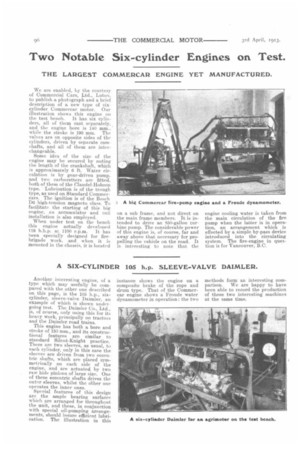Two Notable Six-cylinder Engines on Test.
Page 14

If you've noticed an error in this article please click here to report it so we can fix it.
THE LARGEST COMMERCAR ENGINE YET MANUFACTURED.
We are enabled, by the courtesy of Commercial Cars, Ltd., Luton. to publish a photograph and a brief description of a new type of sixcylinder Commercar motor. Our illustration shows this engine on
the test bench. It has six cylinders, all of them cast separately, and the engine bore is 140 ram while the stroke is 190 mm. The valves are on opposite sides of the cylinders, driven by separate camshafts, and all of them are interchangeable.
Some idea of the size of the engine may be secured by noting the length of the crankshaft, which is approximately 6 ft. Water circulation is by gear-driven pump, and two carburetters are fitted, both of them of the Claudel-Hobson type. Lubrication is of the trough type, as used on Standard Commercars. The ignition is of the Bosch D6 high-tension magneto class. To facilitate the starting of this big engine, an accumulator and coil installation is also employed. When under test on the bench this engine actually developed 119 b.h.p. at 1100 r.p.m. It has been specially designed for firebrigade work, and when it is mounted in the chassis, it is located on a sub frame, and not direct on the main frame members. It is intended to drive an 850-gallon turbine pump. The considerable power of this engine is, of course, far and away above that necessary for propelling the vehicle on the road. It is interesting to note that. the engine cooling water is taken from the main circulation of the fire pump when the latter is in operation, an arrangement which is effected by a simple by-pass device introduced into the circulating system. The fire-engine in question is for Vancouver, B.C.






















